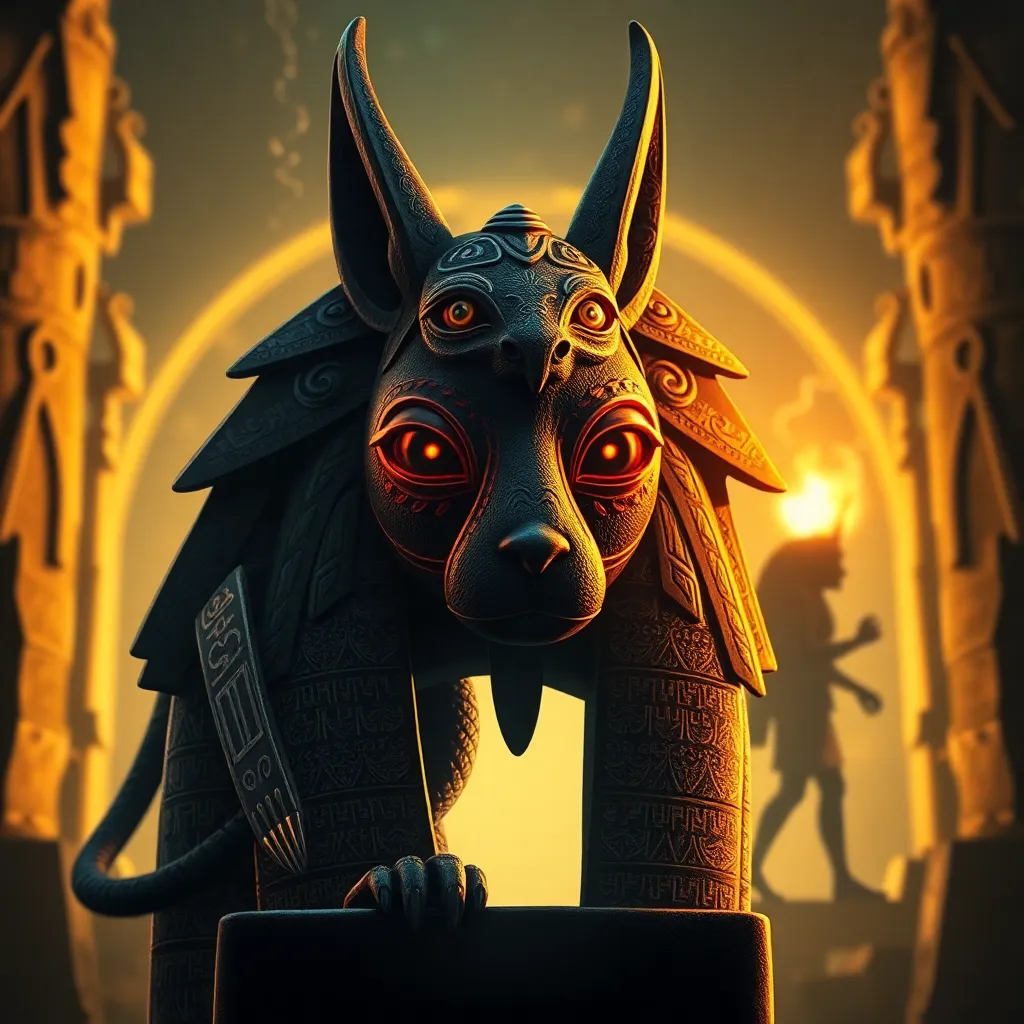The Anubis Mythology: A Window into the Ancient Egyptian Worldview
I. Introduction
Anubis, the enigmatic jackal-headed deity, occupies a pivotal role in ancient Egyptian mythology. This article explores the significance of Anubis in understanding the beliefs, practices, and worldview of the ancient Egyptians. Recognized primarily as the god of the afterlife and mummification, Anubis embodies the Egyptians’ complex relationship with death, the afterlife, and the rituals that accompany them. The purpose of this article is to provide a comprehensive overview of Anubis, from his historical context to his modern interpretations.
II. Historical Context of Anubis
Anubis’s origins can be traced back to the early dynastic period of ancient Egypt, where he was revered as a protector of the dead and a guide to the afterlife.
A. Origins of Anubis in Ancient Egyptian Religion
The earliest references to Anubis appear in the Pyramid Texts, dating back to the Old Kingdom (c. 2686–2181 BCE). Initially depicted as a purely funerary deity, he was associated with the process of embalming and the protection of tombs.
B. Evolution of Anubis’s Role Over Different Dynasties
Over time, Anubis’s role expanded significantly. During the Middle Kingdom (c. 2055–1650 BCE), he became more closely associated with the weighing of the heart ceremony, emphasizing his role in judgment and the afterlife. By the New Kingdom (c. 1550–1070 BCE), Anubis was often depicted alongside Osiris, the god of the afterlife, indicating a shift in the narrative surrounding death and resurrection.
C. Comparison with Other Deities in the Egyptian Pantheon
- Osiris: While Anubis is primarily associated with funerary rites, Osiris embodies resurrection and eternal life.
- Isis: As the goddess of magic and motherhood, Isis played a critical role in Osiris’s resurrection, highlighting the interconnectedness of the deities.
- Thoth: The god of wisdom and writing, Thoth was often depicted alongside Anubis during the weighing of the heart ceremony, emphasizing the importance of knowledge in the afterlife.
III. The Symbolism of Anubis
Anubis is rich in symbolism, representing various aspects of death and the afterlife.
A. Representation of Death and the Afterlife
As the god who oversees the dead, Anubis symbolizes the transition between life and the afterlife. His presence in tombs and funerary texts underscores his role as a guide for the deceased.
B. Iconography: Jackal Head and Its Significance
The jackal head of Anubis is significant in several ways:
- Association with Tombs: Jackals were commonly found in cemeteries, scavenging on the remains of the dead, which made them a natural symbol for a deity associated with death.
- Protection: The jackal’s nocturnal nature and stealth contributed to Anubis’s role as a protector of the deceased.
C. Anubis as a Guide for Souls in the Duat (Underworld)
In the Duat, Anubis acts as a psychopomp, leading souls through the afterlife, ensuring they reach their destination safely. His guidance is crucial for the souls navigating the dangers of the underworld.
IV. Anubis’s Role in Funerary Practices
Funerary practices in ancient Egypt were elaborate and deeply intertwined with the worship of Anubis.
A. The Importance of Mummification and Burial Rituals
Mummification, a key aspect of funerary practices, was believed to preserve the body for the afterlife. Anubis was integral to this process, overseeing the embalming rituals and ensuring the deceased was prepared for their journey.
B. Anubis as Protector of the Dead
As the guardian of tombs, Anubis was invoked in spells and prayers to protect the deceased from harm and ensure a safe passage to the afterlife.
C. Rituals and Offerings Associated with Anubis
Offerings to Anubis often included food, incense, and symbolic items placed in tombs to appease him. Rituals performed in his honor included:
- Recitations of prayers and spells.
- Offerings of goods to facilitate the deceased’s journey.
- Rituals involving the embalming of the body.
V. The Weighing of the Heart Ceremony
One of the most significant aspects of Anubis’s mythology is his role in the weighing of the heart ceremony.
A. Description of the Ceremony and Its Significance
In this ceremony, the heart of the deceased was weighed against the feather of Ma’at, the goddess of truth and justice. This evaluation determined the soul’s fate in the afterlife.
B. Anubis’s Role as the Judge and Guide
Anubis is depicted as the judge in this ceremony, carefully weighing the heart and ensuring the process is fair and just. His presence signifies the importance of morality and truth in ancient Egyptian beliefs.
C. Implications of the Ceremony for the Ancient Egyptian Moral Code
The outcome of the ceremony had profound implications for the deceased’s eternal fate, reinforcing the moral values of honesty, integrity, and the importance of living a righteous life.
VI. Anubis in Art and Literature
Anubis has been depicted in a variety of artistic forms throughout ancient Egyptian history.
A. Depictions of Anubis in Tomb Paintings and Sculptures
Artworks often portrayed Anubis as a jackal or a man with a jackal head, frequently found in tombs to protect the deceased. Notable examples include:
- Tomb paintings in the Valley of the Kings.
- Statues in funerary temples dedicated to Anubis.
B. References to Anubis in Ancient Texts and Inscriptions
Ancient texts, such as the Pyramid Texts and Coffin Texts, contain numerous references to Anubis, detailing his role in funerary rites and the afterlife.
C. Influence of Anubis on Later Cultures and Media
The figure of Anubis has influenced various cultures and media, appearing in literature, art, and modern interpretations of mythology. His representation continues to resonate in contemporary narratives.
VII. Anubis in Modern Culture
Anubis’s legacy extends beyond ancient Egypt into modern culture.
A. How Anubis is Perceived in Contemporary Society
In contemporary times, Anubis is often viewed as a symbol of mystery and the unknown aspects of death. His image is popular among those interested in ancient cultures and esoteric traditions.
B. Anubis in Popular Culture: Movies, Books, and Games
Numerous movies, books, and video games feature Anubis, showcasing his role as a powerful deity. Examples include:
- Films like “The Mummy” series.
- Video games such as “Assassin’s Creed” and “Smite.”
- Literary works that incorporate Egyptian mythology.
C. The Resurgence of Interest in Ancient Egyptian Mythology
Recent years have seen a resurgence of interest in ancient Egyptian mythology, with Anubis often at the forefront, captivating the imagination of scholars and enthusiasts alike.
VIII. Conclusion
Anubis holds a significant place in the ancient Egyptian worldview, representing the complexities of death, the afterlife, and moral integrity. His enduring legacy speaks to the importance of understanding ancient beliefs and practices, as they offer insight into the human condition across cultures and time periods. As we reflect on Anubis’s significance, we recognize the relevance of ancient mythology in contemporary society, continuing to inspire and provoke thought about life, death, and the mysteries that lie beyond.



